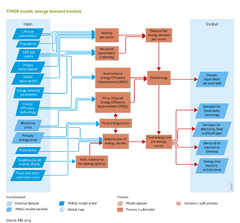Energy demand/Description: Difference between revisions
Jump to navigation
Jump to search
Oostenrijr (talk | contribs) No edit summary |
Oostenrijr (talk | contribs) No edit summary |
||
| Line 67: | Line 67: | ||
The model distinguishes five income quintiles for both the urban and rural population. After determining the energy demand per function for each population quintile, the choice of fuel type is determined on the basis of relative costs. This is based on a multinomial logit formulation for energy functions that can involve multiple fuels, such as cooking and space heating. In the calculations, consumer discount rates are assumed to decrease along with household income levels, and there will be increasing appreciation of clean and convenient fuels ([[Van Ruijven et al., 2011]]). For developing countries, this endogenously results in the substitution processes described by the energy ladder. This refers to the progressive use of modern energy types as incomes grow, from traditional bioenergy to coal and kerosene, to energy carriers such as natural gas, heating oil and electricity. | The model distinguishes five income quintiles for both the urban and rural population. After determining the energy demand per function for each population quintile, the choice of fuel type is determined on the basis of relative costs. This is based on a multinomial logit formulation for energy functions that can involve multiple fuels, such as cooking and space heating. In the calculations, consumer discount rates are assumed to decrease along with household income levels, and there will be increasing appreciation of clean and convenient fuels ([[Van Ruijven et al., 2011]]). For developing countries, this endogenously results in the substitution processes described by the energy ladder. This refers to the progressive use of modern energy types as incomes grow, from traditional bioenergy to coal and kerosene, to energy carriers such as natural gas, heating oil and electricity. | ||
The residential submodule also includes access to electricity and the associated investments ([[Van Ruijven et al., 2012]]). Projections for access to electricity are based on an econometric analysis that found a relation between level of access , and GDP per capita and population density. The investment model is based on population density on a 0.5 x 0.5 degree grid, from which a stylised power grid is derived and analysed to determine investments in low-, medium- and high-voltage lines and transformers. | The residential submodule also includes access to electricity and the associated investments ([[Van Ruijven et al., 2012]]). Projections for access to electricity are based on an econometric analysis that found a relation between level of access , and GDP per capita and population density. The investment model is based on population density on a 0.5 x 0.5 degree grid, from which a stylised power grid is derived and analysed to determine investments in low-, medium- and high-voltage lines and transformers. See additional info on [[Grid and infrastructure]] | ||
}} | }} | ||
Revision as of 14:03, 10 August 2015
Parts of Energy demand/Description
| Component is implemented in: |
|
| Related IMAGE components |
| Projects/Applications |
| Key publications |
| References |
